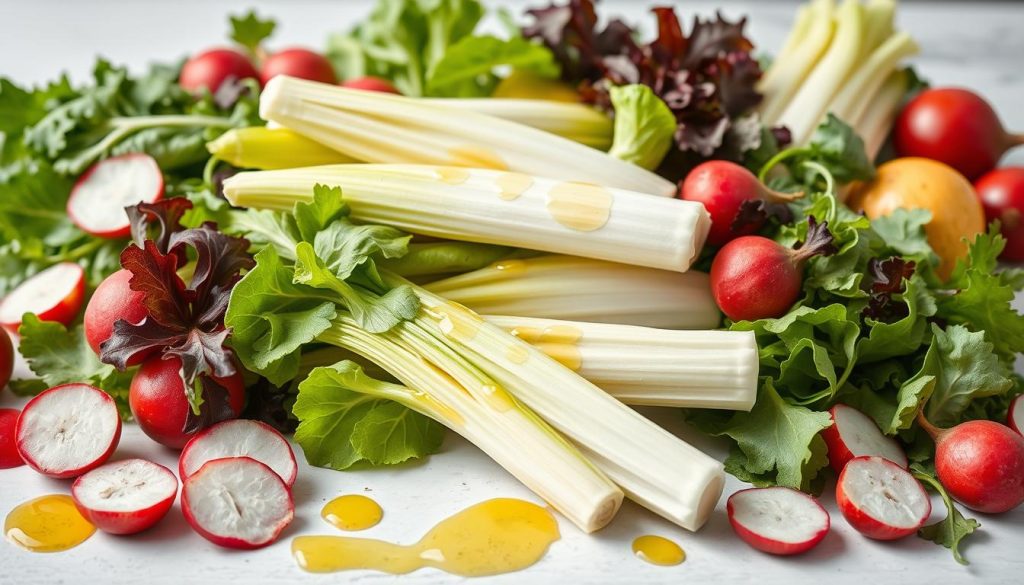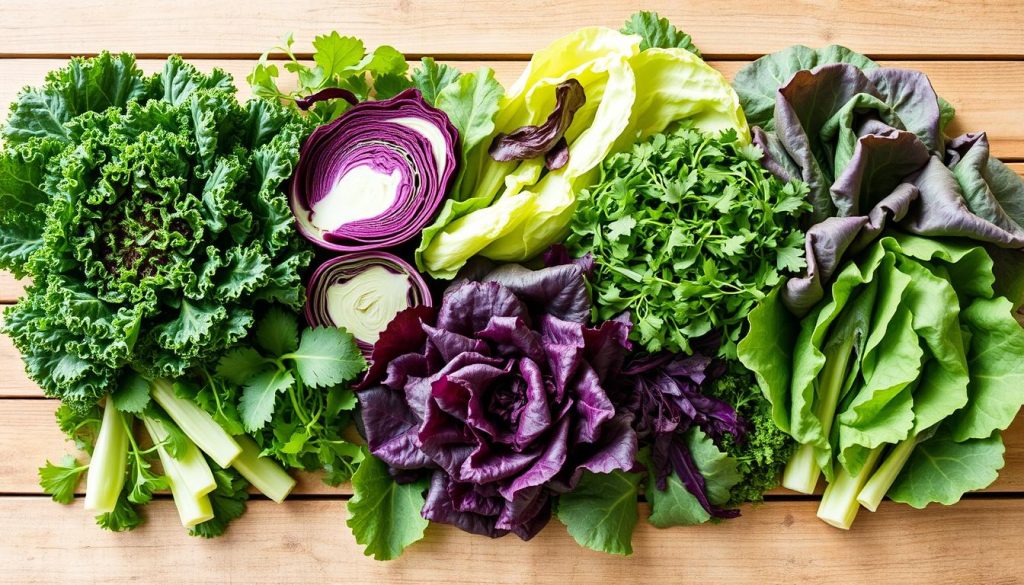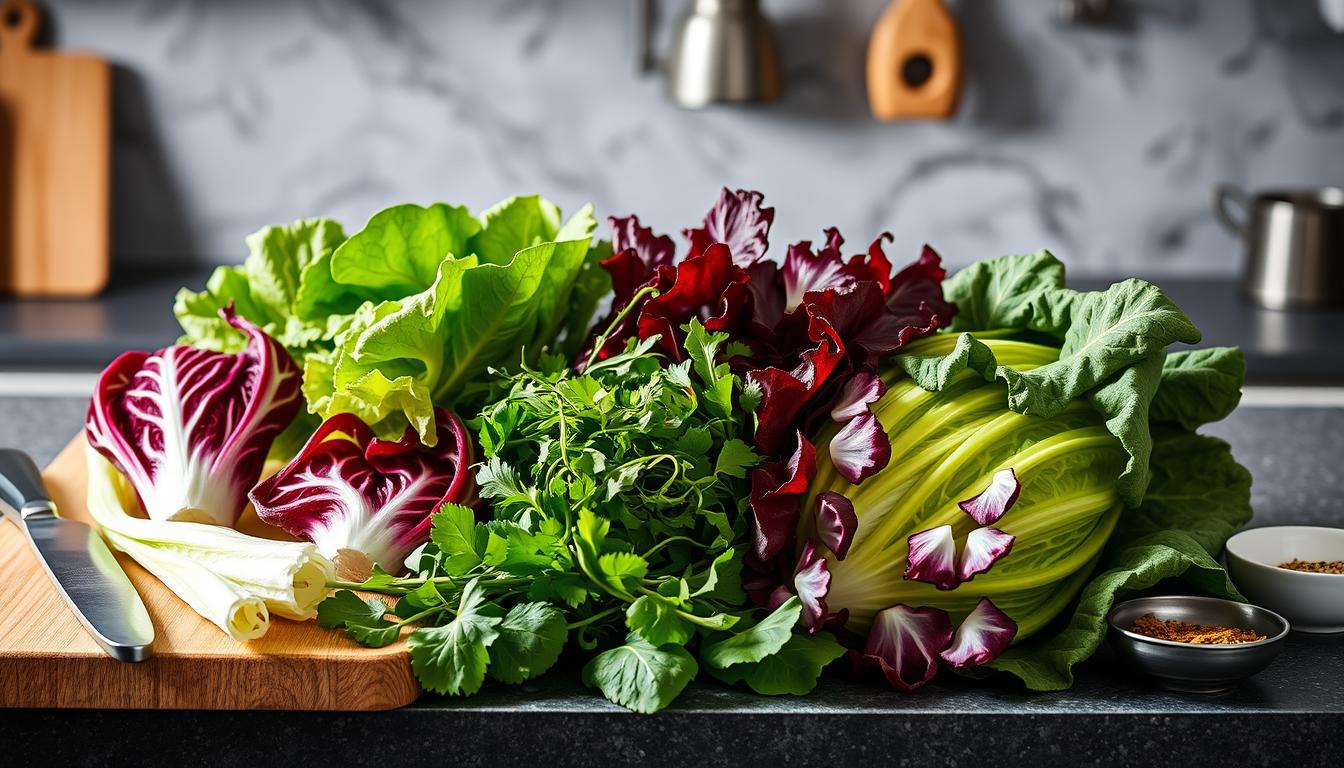Endive is a leafy vegetable known for its crisp texture and slightly bitter taste. It’s great in salads and appetizers. But, if you can’t find endive or want something milder, there are many alternatives. This guide will show you the best veggie swaps for your recipes.
We’ll look at options like radicchio, watercress, and romaine lettuce. Each has its own taste and texture. We’ll also talk about the health benefits of these alternatives. Whether you need something crunchy for your salad or a bit of bitterness, we’ve got you covered.
What is Endive?
Endive is a leafy green vegetable from the chicory family. It’s known for its crisp texture and slightly bitter taste. It’s great in salads and as a garnish.
There are two main types of endive: Belgian endive and curly endive. Belgian endive is pale and cylindrical, with a delicate flavor. Curly endive, or frisée, has lacy, frizzy leaves that make dishes unique.
Both types of endive add flavor to meals and are packed with nutrients. They have about 93.8 grams of water per 100 grams. This makes them low in calories, with just 17 kcal.
Endive is also low in carbs and high in protein. It has 3.35 grams of carbs and 1.25 grams of protein per serving. Plus, it has 3.1 grams of dietary fiber, which helps with digestion and blood sugar.
Endive is full of vitamins and minerals. A 100-gram serving has calcium, phosphorus, sodium, potassium, and vitamins A and K. Vitamin K is important for bone health and blood clotting.
Endive also has beta-carotene, which is good for the eyes. So, adding endive to your diet can be very beneficial.
Understanding the Flavor Profile of Endive
Endive has a unique flavor profile with a crisp texture and sharp bitterness. This bitterness makes it stand out. In raw form, the white veins of the leaves are very bitter, offering a strong flavor.
When cooked, endive becomes milder and slightly sweet, like caramel. This is true when it’s grilled or sautéed.
Deciding whether to use raw or cooked endive depends on your dish. Raw endive adds a crunchy, refreshing touch to salads. It pairs well with citrus and blue cheese, balancing its bitterness.
For example, a salad with endive, radicchio, blood orange, and walnuts, dressed with a light vinaigrette, is a delightful mix of flavors.

Cooked endive, on the other hand, works well in warm dishes like pasta or risotto. Its texture softens, and its bitterness reduces, making it more versatile in cooking.
Understanding how endive’s flavor changes can really improve your cooking. It’s all about knowing when to use it raw or cooked.
| Preparation Method | Flavor Characteristics | Best Uses |
|---|---|---|
| Raw | Intense bitterness, crisp | Salads, garnishes |
| Cooked | Mild, slightly sweet, softer texture | Pasta, casseroles, soups |
Endive Substitute Guide: Best Veggie Alternatives
Looking for endive substitutes? There are many veggie options that taste and feel similar. These alternatives can add new flavors and textures to your dishes. Here are some top picks for your kitchen.
Radicchio as an Endive Substitute
Radicchio adds a vibrant touch to salads, just like endive. It’s part of the chicory family and can be eaten raw or cooked. Cooking it brings out its sweetness, making it great for many recipes.
Watercress for a Fresh Twist
Watercress has a peppery taste that’s similar to endive’s bitterness. Its soft texture is perfect for salads or sandwiches. It adds a bold flavor that can make your meal stand out.
Napa Cabbage: A Milder Option
Napa cabbage is softer and milder than endive. It has a crunchy, sweet flavor that’s great in salads and cooked dishes. This makes it a versatile choice for experimenting with different textures.
Chicory Leaves: A Close Relative
Chicory leaves are very similar to endive, with a similar bitter taste. They work well in both raw and cooked dishes. Chicory is a reliable choice for keeping that familiar taste in your recipes.
Romaine Lettuce: A Crispy Stand-in
Romaine lettuce is crunchy and crisp, making it a good substitute for endive. It’s perfect for salads and raw dishes. If you want something lighter, romaine is a great option.

Culinary Uses of Endive
Endive is a versatile leafy green that can make your dishes better. It has unique flavors and textures for both raw and cooked uses. Learning how to use endive can make your meals more exciting and impress your guests.
Raw Preparations
Endive’s firm, crunchy texture is great in salads. Its slightly bitter taste balances well with sweet fruits or creamy cheeses. You can use whole leaves or strips in salads like the classic salad Lyonnaise.
Using endive leaves as edible vessels for appetizers adds a fancy touch to any event.
Cooking with Endive
Cooking endive opens up many possibilities. You can stir-fry, braise, or grill it to soften its natural bitterness. This makes it taste inviting when paired with sweet or acidic foods.
Endive is excellent in pasta dishes or as a wrap for fish or beef. Its versatility makes it perfect for many entrées and sides, helping you use it to its fullest potential.
Comparing the Nutritional Benefits
Endive is packed with nutrients and has very few calories. A 2-cup serving of endive has just 8.5 calories. It also scores high on the Nutrivore Score, showing it’s very nutritious.
Endive is a powerhouse of vitamin K, giving you 193% of your daily needs in 2 cups. This vitamin is key for blood clotting and strong bones. It’s also rich in folate (Vitamin B9), with 36% of your daily needs in just 2 cups. Folate is important for cell growth and repair.
Other greens like radicchio, watercress, and romaine lettuce offer similar benefits to endive. For example, watercress gives you 71% of your daily vitamin K in one cup. Romaine lettuce provides about 68% of your daily vitamin K in the same amount.
Adding these greens to your meals can greatly benefit your health. Leafy greens like endive and its alternatives have been shown to reduce the risk of chronic diseases. Eating them regularly can help prevent type 2 diabetes and colorectal cancer. They also help keep your mind sharp as you age. A diet full of vegetables like endive can improve your overall health and extend your life.
How to Select and Prepare Endive Alternatives
Choosing the right fresh vegetables can make your cooking better. It’s important to pick substitutes that taste and feel like endive. This way, your dishes will be just as good. Here are some tips on how to store and prepare these veggies.
Storage Tips for Freshness
Keeping your veggies fresh is key. Here’s how to do it:
- Store them in the fridge.
- Use bags with holes or damp paper towels to keep them moist.
- Make sure they stay cool and moist.
These steps help radicchio, watercress, napa cabbage, chicory leaves, and romaine lettuce stay fresh and tasty.
Prep Techniques for Different Substitutes
How you prepare endive substitutes depends on the veggie. Here are some tips:
| Substitute | Preparation Method |
|---|---|
| Radicchio | Enjoy raw in salads or grilled for a warm, smoky flavor. |
| Watercress | Use fresh in salads for a peppery taste or blend into soups for added nutrients. |
| Napa Cabbage | Ideal for quick cooking methods or raw in slaws due to its crunchy texture. |
| Chicory Leaves | Serve raw in salads or cook them lightly to balance their bitterness. |
| Romaine Lettuce | Use fresh as a salad base or as a crispy addition to various dishes. |
Knowing how to prepare endive substitutes can make your meals better. Choosing fresh veggies and storing them right can really improve your dishes.
Conclusion
Finding good substitutes for endive can really boost your cooking skills. Each alternative has its own special traits. By choosing radicchio, arugula, or chicory, you open up a world of creativity in your kitchen.
These substitutes can add new tastes and textures to your food. For example, radicchio can bring a deep flavor to your dishes, perfect for fall and winter. It’s a great swap that keeps your recipes exciting.
Exploring these vegetable swaps can also meet your dietary needs. It’s a win-win for your taste buds and your health. So, as you try out these substitutes, you’ll find endless ways to make your meals both healthy and tasty.
Source Links
- https://discover.texasrealfood.com/swap-and-savor/endive-curly-endive-substitutes
- https://discover.texasrealfood.com/swap-and-savor/how-to-substitute-endive-for-lettuce
- https://www.healthifyme.com/blog/endives/
- https://cookscrafter.com/endive-substitutes/
- https://boxwoodavenue.com/endive-salad/
- https://neweltastingtable.com/endive-appetizer-blue-cheese/
- https://girlmeetsfood.com/endive-substitute/
- https://www.bmc.org/nourishing-our-community/teaching-kitchen/substitution-guide
- https://www.cozymeal.com/magazine/endive
- https://nevegetable.org/crops/lettuce-endive-and-escarole
- https://nutrivore.com/foods/endive-nutrients/
- https://www.webmd.com/diet/what-health-benefits-endive
- https://www.healthline.com/nutrition/leafy-green-vegetables
- https://gustomeadow.com/endive-substitutes/
- https://www.thedailymeal.com/1323915/what-need-know-about-cooking-endives-guide/
- https://discover.texasrealfood.com/swap-and-savor/how-to-substitute-endive-for-radicchio
- https://apnaugao.com/blogs/posts/the-complete-guide-to-growing-chicory-endive-in-pakistan?srsltid=AfmBOoo1s3HTR9O4cnpUjSZNTP2corybZ6InqjytJPBTTbFusb_MPhMk
